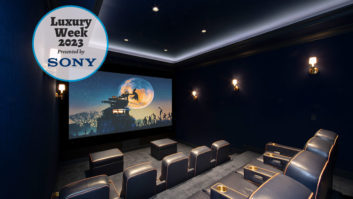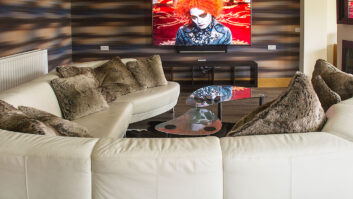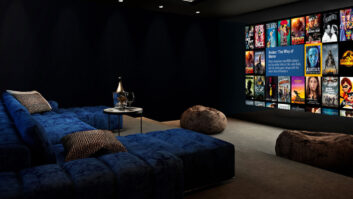In the 1987 movie Overboard, actress Goldie Hawn plays Joanna, an uber-wealthy heiress whose yacht pulls into Elk Cove, OR for repairs. Bored, she hires local carpenter Dean Proffitt (played by Kurt Russell) to remodel her yacht’s outrageously large walk-in closet.
Proffitt, after several long days of hard work in hot weather, builds a pretty spectacular closet with a clever, custom-designed, spring-loaded shoe carousel to house Joanna’s massive assortment of designer shoes. On a tour of the completely remodeled closet, Joanna asks Proffitt what kind of wood he used. When he tells her oak, she explodes into a fury, declaring she’s not paying him for any of his work because everyone knows you make closets out of cedar. “Well you may have wanted cedar, but you didn’t ask for cedar,” Proffitt retorts. “It’s no problem,” he declares. “But I have to tell you it’s going to more than double my estimate.” Joanna storms off in a huff up to the main deck, firing Proffitt and throwing his large toolbox–his livelihood–into the bay.
It may be Hollywood, but this depiction of a difficult luxury client is not too far from reality, according to several integrators we spoke with about the challenges of serving the luxury market with large, sophisticated projects. The key to success is learning how to effectively manage the luxury client.
“Luxury clients are very demanding…absolutely,” Al Reinhard, owner of AHT Global in Miami, FL, said. “Demanding, and at times, unreasonable. They’re used to getting everything they want.”

“The luxury client is a very demanding client,” said Navot Shoresh, owner of Troy, MI-based Spire Integrated Systems. “People who are paying at this level usually have very high expectations…if at times unrealistic.”
“Rather than ‘luxury clients,’ I would call them ‘high-end, high-expectation clients,’” David Rogers of Dallas Sight and Sound in Texas said.
Finally, Dave Raines, president and CEO of Osbee in Harrison, NY, added rather optimistically, “Most clients are demanding, but can be reasonable.” He means they can be reasonable, but only if you know how to handle them.

High-flying integrators who have risen into the rarefied air of high-stakes, high-end luxury installations–loosely defined as high six-figure to low seven-figure projects (and up)–have developed a customized set of tools to deal with the unique attributes of these clients. They also warn that this business is risky, challenging, and reserved only for those who are prepared to remake their companies in order to meet the special needs of this top-percentile demographic.
Being a Business Partner
To begin, it’s important to understand what these types of clients are looking for in an AV integrator for their projects–usually either new construction or significant remodels of existing homes.
“The biggest thing in catering to the luxury market is availability [of the staff and owner] to your client and customer service,” Reinhard explained. “It’s really about making sure that they’re taken care of by someone in your organization. Even though somebody on my staff is working with a client, I always tell my clients, ‘You can always call me if you feel you need to speak with me. If you have a problem, please call me,’” he added, noting that clients have his personal cell phone number.
“With high-end, high net-worth clients, it’s all about trust,” Shoresh said. “We walk them around our entire office. Most luxury clients are businesspeople, and they want to see that they’re working with a businessperson. I show them all of our processes. I [explain] our core values and take them through the design department, the warehouse, the rack building area…everything. You have to talk to them on their level.”

Reliability, First and Foremost
According to the integrators interviewed, the single most important goal of the luxury buyer is a reliable system. While this is high on the list of priorities for any home automation customer, it is absolutely paramount for the luxury client.
“Reliability is the most important thing,” said Dave Raines. “Many of them have had a solution before that’s automated, whether it be Crestron, Savant, or Control4, and they seek our advice.” Raines noted that often this previous experience was a nightmare, or an otherwise unsatisfactory experience. The client hopes to rectify this with a new, more reliable solution.
“Reliability is the highest requirement and trending upward,” Rogers laughed. “And it’s really borne out of the frustration of how technology has become so widespread. Yet in many ways, the quality has trended down,” Rogers added, noting the day-in/day-out challenges and confusion of using wired and wireless systems streaming relatively low-quality, internet-based music through apps.
The Value of Aesthetics
After reliability, the panel agreed that the next-most important system element to the luxury client is aesthetics. How the system looks and how it blends in with the interior design of the home is often more important than even its sound and visual performance.
“Aesthetics is the next most important thing, for sure,” Raines said. “We wouldn’t be where we are with the clients we have today if this wasn’t what we were dealing with. And aesthetics is the number-one factor to a client if they have hired that kind of high-end architect.”
AHT Global’s Reinhard noted that aesthetics is often the prime factor when it comes to product selection. Since most of their clients are working with high-end designers, aesthetics can become most important.
“We engineer our systems based on the quality of the home,” Reinhard said. “I’m not putting typical $100 round, in-ceiling speakers in an amazing ceiling that they’ve put a lot of time and detail in to have trimless lights, and trimless AC diffusers. You have to go with something like a Trufig model that flushes in. You try to match the products to the house.
“These decisions are being made by their designer,” Reinhard added. “So that’s driven purely by the aesthetics of the house. Sometimes technology is driven by the design.”
Rogers agreed that aesthetics are very important to the luxury client. “Since everything in their house is custom, they may want a special type of wall plate that is going to be flush mounted and will completely blend in,” he said. “A lot of the time we spend on these high-end projects is around that.”
If you think you can come into the luxury market with a standard plastic keypad, the same one you use with every one of your other clients, you may get rejected, Shoresh noted. “We’re seeing a lot of increase now in the use of the Palladiom keypad from Lutron, simply because the aesthetics.”
Other System Features
Digging a little deeper, the panel revealed some of the other, more tangible products, features, and services that luxury clients are seeking.
“I typically see them looking to go much higher end on the audio, higher performance [overall], more motorization–either lift, shades, drapery…just more unique applications,” Shoresh said. “The finishes are higher end, they expect better looking keypads, more invisible speakers, more motorization of hidden things around in cabinetry, like lifts and such.”
“Most luxury clients are looking for custom architectural solutions,” Raines said. “So that’s motorization, custom plates, custom window treatment, and the like.”
“If you have more money, you’re going to probably have an amazing outdoor space,” Reinhard added. “So you’re going to want to enjoy that outdoor space, and you may have a huge requirement for an outdoor AV system. We do plenty of those that go well up into the hundreds of thousands of dollars just for the outdoor system because the grounds are so vast.
“So we see demand for things like outdoor audio and video systems, and very intricate home theaters where you can spend lots of money…these are some of the requests we get.”
Managing Expectations
Is there a method, a strategy–some kind of key to working with these demanding clients and successfully completing their large installations…and getting paid? One approach is learning how to best manage expectations.
“The number one takeaway–if you’re going to quote me on anything about this business–is to manage expectations,” Raines said, firmly. “Most clients are demanding but can be reasonable; they are still human beings. If something is not going to work out, you don’t just walk in and tell them that it didn’t work out…you foreshadow what is going on. Or you let them know, tactfully, that your contractor is late on this project and therefore the day you move in, you won’t have television. There’s a lot of tact and politics necessary.”

Dallas Sight and Sound’s Rogers agreed: “I really think the focus is on managing expectations. And it starts long before the relationship ever begins between our company and the client. We’re going to do whatever we can to attract the right type of client for us. When we initially meet with a client like this–they found us through some kind of a referral–we’ve already been vetted at some level to at least be getting the meeting. We just have sort of what we call a ‘proven process’ to start the relationship off with this kind of client by properly setting their expectations.”
No matter where the client starts the conversation in that initial meeting, Rogers said, “We steer it back to, ‘Tell us about your lifestyle…tell us about the project…tell us about what your vision is…how technology will exist within your home.’ This way we’re able to find out what level of understanding they have about technology–what sort of expectations they have. Our approach is always to deemphasize the equipment, deemphasize the actual technology, and emphasize them understanding what the process is and that we want them to enjoy the process and not feel rushed. This proven process works for all personality types.”
Configuring Your Business
With knowledge of what top-end clients demand, how should you begin setting your business up to satisfy them? Here are some of the primary things you must do to ensure a process that delivers the project on time, on budget, and fully billable.
A Top-Notch Team: “You need dedicated project managers per project…hands down,” Osbee’s Raines said. “And that project manager cannot be working on more than five projects at any one time. In our case, five is the max–four is the average. I have some project managers that are only working on one project.
In addition to this, Raines added, “I have a very large back-end administrative staff and the reason for this is managing expectations. It’s making sure you get back to clients when their Apple TV isn’t working just to make them happy…just to let them know you’re out there. Having someone 24-hours a day sitting in front of an email support system, just to make sure it’s there–and that’s a real employee. Having meeting minutes taken so that after every meeting you can send them out to all participants with a full report of what was discussed. Basically, we document everything.”
Shoresh agreed, saying, “You have to put a lot of time into the management of the project. You have to put a lot of time into repeat travel for little details–moving this/moving that…especially when the project takes two or three years to complete.
“You have to have a very, very good design team. And you have to have very, very good recordkeeping. You know change orders occur on a job on a very regular basis, so not having a signature on what the designer picked for colors, or not having a signature on a change order can kill you. If you didn’t get an approval from the designer, the architect, and the homeowner on a shades order, for example, and you ordered the wrong thing–that can kill you. In the luxury market, one mistake can basically wipe out any potential earnings you had on the entire project–and quite honestly, I’ve seen companies come crashing down because of it.”
24/7 After-Hours Service & Support: Dallas Sight and Sound’s Rogers said that two or three weeks after his company was founded [in 1984], it started offering 24/7 on-call service because, “we realized that it’s not about the audio and the video that we’re putting in–it’s about being there for the client when they can’t get something to work. Back in the day, I had about a 90-percent success ratio of talking people through things. To me, it’s kind of what it takes to be successful serving that type of client,” he said.
“Maybe it’s not 24/7, but it has to be as close to 24/7 as possible,” Reinhard agreed. “Our clients have the PM’s phone number, and they have our personal phone numbers, as well. I’ve answered calls at three in the morning from a drunken client. It’s OK…”
“Luxury clients require luxury support after the project is done,” Shoresh said. “Having support available on nights and weekends is essential. We provide 24/7 free phone support to all of our clients and we have personnel on-call for any emergency on-site needs.”
Fair Warning
Virtually the entire panel made it clear that bidding on a big, luxury installation is a big risk for any integrator. Yes, they are hard to pass up, as they can turn into bragging rights that you can share for years. But consider this path carefully.
“Integrator beware of what you’re getting yourself into,” Shoresh said. “And make sure you have the skillset to do it. Keep records of everything…get signatures on everything…don’t confuse, ‘That sounds like a great idea’ with ‘Yeah, let’s do it,’ because you’re going to end up doing it and paying for it because they didn’t approve it. When putting a proposal together, carefully calculate your hours, and then add more. And if it doesn’t fit and the client says your price is too high–walk away. Let somebody else lose money on that one. You’ll have one less competitor in a year.”







